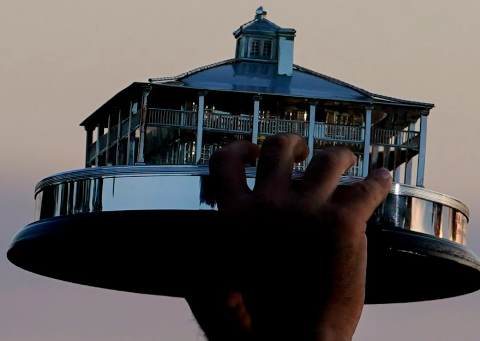
By: Allison Skinner
Two leading members of Pussy Riot, Nadezhda Tolokonnikova and Maria Alyokhina, left their bright-colored balaclavas in Russia, bringing their anti-Putin sentiments to America for the first time in early February. The punk band’s arrival in New York City solidified their global celebrity status by being introduced by Madonna as “freedom fighters” at the Amnesty International benefit concert, making derisive Putin jokes on The Colbert Report, rubbing shoulders with Hollywood actors at a party thrown in their honor, and being escorted around New York City in black S.U.V.’s for meetings with political and cultural elites. The punk band’s crusading mission, however, was to study the United States’ prison system for their new political platform: prison reform.
Pussy Riot garnered initial international attention when three members were arrested for performing an anti-Putin, feminist themed punk song at a Moscow cathedral. With the charge of “hooliganism motivated by religious hatred”, Nadezhda Tolokonnikova and Maria Alyokhina were sentenced to two years at separate prisons. Yekaterina Samutsevich, the third member, was given a suspended sentence on appeal because the court believed she did not fully participate in the protest. After Western criticism of their incarceration, a letter released by Tolokonnikova detailing her incurred human rights abuses, and increased controversy surrounding the Sochi Olympics, Vladimir Putin released the two punk band members after 21 months of imprisonment, three months shy of their initial sentence length.
Putin may have hoped their release would ease Western humanitarian concerns, but Pussy Riot came out of prison as loudly as they entered. Tolokonnikova and Alyokhina went on a world tour of prisons and media events in hopes to learn of different prison systems and maintain an international voice against Putin’s policies. While in New York, Pussy Riot visited a West Harlem halfway house and, at the behest of Mayor De Blasio, Rikers Island jail complex.
Based on Pussy Riot’s experience in Russian prisons, what can Pussy Riot learn from the U.S. prison system?
In September 2013, Tolokonnikova released a letter titled “Why I Have Gone on Hunger Strike”, where she details her prison conditions at Penal Colony No. 14. Russian prisons resemble the gulag archipelago in that inmates are housed in barracks in open campus to support industrial scale production and prison gangs. Tolokonnikova describes her work camp as an environment of physical and mental deprivation. Prisoners work 17-hour days sewing police uniforms with faulty equipment. Basic needs, such as food and hygiene, are scarce and further reduced as a form of collective punishment. Guards instigate fights among prisoners, and support gangs as a way to control the inmate population. Maria Alyokhina said in a Rolling Stone interview that prisoners in her penal colony earned between one and ten euros for one month’s work. When the two Pussy Riot members were released, they vowed to advocate prison reform in Russia and seek the release of protesters serving five to six year sentences for staging a protest against Putin.
Rikers Island is located between Queens and mainland Bronx, and houses roughly 12,300 inmates. Although the facilities only house inmates awaiting trial (prisons house those serving longer sentences), Rikers Island faces issues pertinent to U.S. correctional facilities nationwide. Reviews showed that mentally ill inmates were placed in solitary confinement far too often, sometimes for thousands of days. 40 percent of inmates have been diagnosed with a mental disorder, and since solitary confinement can intensify mental health problems, Rikers faces challenges of handling its growing ill inmate population. Beginning in 2014, Rikers ended its controversial use of solitary confinement for mentally ill inmates.
An abuse of power similar to Tolokonnikova’s experience surfaced in 2009 at Rikers Island when lawsuits accused Rikers guards of recruiting inmates to be “managers, foot soldiers and enforcers,” according to a New York Times article. These accusations said guards looked the other way when beatings of inmates lead to the hospitalization of one victim and the death of another. In 2012, reports surfaced of guards assembling a favored group of inmates called “The Program”. These inmates had the unofficial impunity to physically and mentally harm other inmates, resulting in deaths and brutal beatings. According to the Tolokonnikova’s letter, inmates in charge of the brigades were responsible for terrorizing, depriving, and turning inmates “into speechless slaves.” These methods included beatings, psychological attacks, and increased quota requirements.
Although Rikers Island jail complex and Penal Colony No. 14 share a past of punishing the vulnerable with solitary confinement and using inmates to physically enforce the administration’s status quo, Rikers Island does differentiate itself by providing its inmates with rehabilitation programs. Pussy Riot members visited Rehabilitation Through the Arts, a non-profit organization that works in five New York State prisons to provide inmates with creative outlets, with hopes to study rehabilitative programs they could implement in Russia and the United States.
Rikers Island supports a number of rehabilitation programs including Goldman Sachs’ investment of $10 million in “social impact bonds” to reduce recidivism, a filmmaking course called “Tribeca Teaches” for adolescent inmates, and an intensive drug rehabilitation program.
Only time will tell if Pussy Riot follows through on its goals for prison reform, but from touring the United States prisons, they can learn that the U.S. prison system still solves some of their problems with the easiest solution. Kennedy’s Community Mental Health Act, signed in 1963, was designed to usher mental health patients into their community as productive citizens, but in the past 50 years the law has lead to a significant decrease in mental health care funding. The mentally ill, without the option of a mental health facility, often end up in prison or jail. Rikers Island is one of the three largest mental health care providers in the nation because 40 percent of its inmates have been diagnosed as mentally ill. To address these conflicts, the Rikers Island administration used extreme forms of solitary confinement.
Methods of prison population control serve as another example of the U.S. prison system using the easy way out. Rikers Island’s has a sordid past of guards looking the other way when prison gangs, such as “The Program”, instigate fights with other inmates. In 2008, an 18-year-old, who was in Rikers Island for stealing a cell phone, died from being beaten by three other inmates. The Stanford Prison Experiment, a 1971 simulation study where individuals were assigned the roles of “guards” or “prisoners”, reflects the physical and mental abuses that arise when one group is given unrestricted power over the other. These abuses included being stripped naked, deprived of sleep and hygiene, sprayed with mace, and beaten. When Tolokonnikova arrived at Penal Colony No 14, an inmate told her, “The pigs [police] are scared to touch you themselves. They want to do it with the hands of the inmates.”
Although U.S. prisons acquiesce to methods that can intensify mental illness and violence, inmates have the right to file lawsuits for their grievances and non-federal institutions can invest in rehabilitation programs. Controversies surrounding Rikers Island’s treatment of the mentally ill and inmate violence began with lawsuits filed by inmates or their families. Many of these lawsuits end in state settlements, but they do incite the attention of the press and eventually the public. Enough negative attention can result in policy changes, such as Rikers Island ending solitary confinement for the mentally ill. Access to rehabilitation programs, funded by non-profit organizations or private companies, allow inmates opportunities for education, job-training, and therapy that a prison or jail may not have funds for.
Members of Pussy Riot do not have the same opportunities to criminally charge the Russian prison system with abuses of power. Tolokonnikova’s filed multiple grievances with no answer, and resorted to a hunger strike for her voice to be heard. Inmates of Russian work camps do not have the opportunity to leave prison a rehabilitated person because they are forced to work upwards of 17 hours a day. A prison sentence in Russia is as much exile as imprisonment.
The one thing Pussy Riot can do, is what the U.S. prison reform proves: if you make your voice heard, people will listen, and things can change. Luckily, no one doubts Pussy Riot’s ability to scream its opinion.

